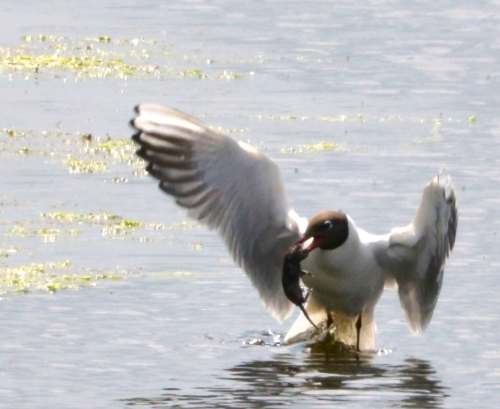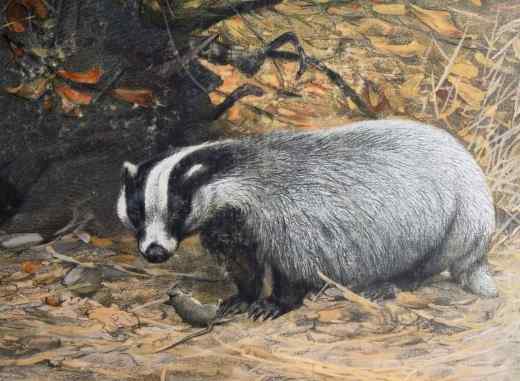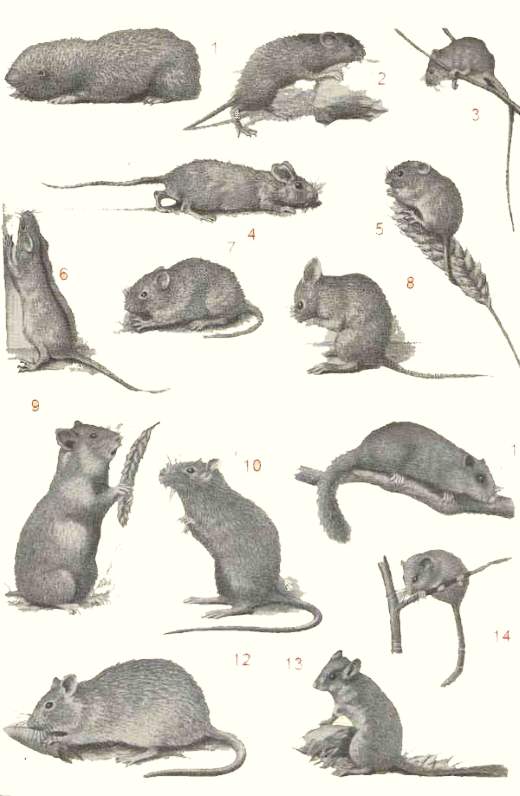Wood mouse
The wood mouse is an European rodent that becomes active during the night. In the summer it can be seen during dusk and dawn. The wood mouse lives in very different habitats like fields, moorlands and even in the moutains, but also, as the name suggests in the woods. The long-tailed field mouse climbs in trees and likes to swimm, even long distances. During the winter they can sometimes be seen in houses, but leave those houses in the spring.

A woodmouse catched by an Black-headed gull The woodmouse is a good swimmer. A photo made by adri
wood mouse and food
The wood mouse is an omnivore, it eats both plants (berries and herbs, but mostly seeds of trees) and animals (mostly snails, but also the insects and spiders that it meats). At the end of the summer it collects acorns and feeds on fungi. Wood mouse need to eat a very large amount of food every day, about one fifth of their body mass daily.
wood mouse and acorns
Wood mouse, jays and squirrels that scatter-hoard acorns in caches for future use, effectively plant acorns in a variety of locations in which it is possible for them to germinate and thrive. The acorns are stored underground often directly under ferns.
Long-tailed Field Mouse distribution
The wood mouse can be found in North of Europe up to the polar circle, like on Iceland.
In the south are the deserts of North Africa the border.
In the east up to the border of Ukraine.
There are many enemies of the wood mouse Here an European badger digs out the hole of the wood mouse. Rats and owls and the European hedgehog are more important. Kestrels, foxes, stoats, weasels and domestic cats are other enemies. By far the largest threat for the wood mouse is starvation.
wood mouse and its hole
The wood mice live together in a large hole during the winter. This hole can be extended.
reproduction of the wood mice.
The wood mouse has a very long breeding season:
from the end of the winter to the end of fall.
During that breeding season the wood mice live solitary.
There are some dominant males that mate with different solitary females.
The gestation period of wood mice is three or four weeks with an avarage of five young.
The offspring become independent after two to three weeks and become already sexually active after two months.
In the second year the mice get there brown colored fur.

Rodents from the book: "wat is dat voor een dier" 1950.
1 greater mole rat or Spalax microphthalmus
2 common vole or Microtus arvalis
3 Northern Birch Mouse or Sicista betulina
4 woodmouse or Apodemus sylvaticus
5 harvest mouse
6 striped field mouse or Apodemus agrarius
7 bank vole or Myodes glareolus or Clethrionomys glareolus
8 house mouse or Mus musculus
9 European hamster or Cricetus cricetus
10 black rat or Rattus rattus
11 Edible dormouse or Glis glis
12 brown rat, common rat, street rat or Rattus norvegicus
13 garden dormouse or Eliomys quercinus
14 hazel dormouse or common dormouse or Muscardinus avellanarius
